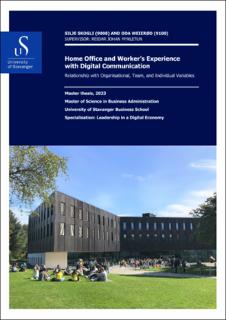| dc.description.abstract | The Covid-19 pandemic caused a worldwide lockdown of society, and created a need for social distancing to prevent further spread of the contagious virus. As a preventive measure, home offices were imposed by authorities in occupations where working remotely was possible. The extended use of home offices and digital communication altered the traditional way of working, and developed new working habits. This thesis’ goal is to investigate the two dependent variables, home office and worker’s experience with digital communication (WEDC), with regard to multiple independent variables. It wants to examine how home office and WEDC relate to one another. Furthermore, the aim is to explore to what extent the organisational dimensions (transformational leadership, autonomy, predictability), the team dimensions (organisational climate, social support, age discrimination), and the individual dimensions (burnout, working hours, gender, age) relate to home office and predict WEDC. Lastly, the purpose is to investigate to what extent the patterns of relationships are similar for home office and WEDC, when predicting from the organisational, team, and individual levels.
The data was collected by Norstat in September 2021 by using a quantitative method from 1531 participants, who were representative of the Norwegian workforce. Validity and reliability were evaluated through the use of factor and reliability analyses. Additionally, Pearson’s bivariate correlation analysis and multiple hierarchical regression analysis were performed. The results showed that home office was positively and significantly correlated to WEDC. All the independent variables were significantly correlated to the dependent variable home office, except gender and age discrimination. The only independent variables that were significantly correlated to the dependent variable WEDC were gender, mental distance (burnout), control of work pacing (autonomy), and control of decisions (autonomy). These were therefore further included in the multiple hierarchical regression. When all relevant variables were added in the regression analysis, control of work pacing and mental distance were both significantly positive predictors. At the same time, gender was a significantly negative predictor in the regression. Control of decisions was not significant in the regression, and the hypothesis regarding the relationship between control of decisions and WEDC was partially confirmed. A low percentage of the total variance for WEDC was explained by the predictors (4.4%). The results suggest further research on predictability, age discrimination, burnout, and gender. | |
